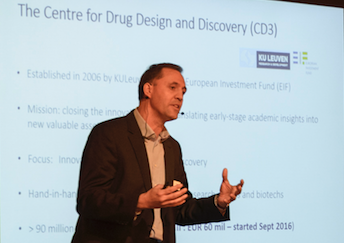The Center for Drug Design and Discovery (CD3), based in Leuven, bridges the gap between innovative biomedical research emerging from academic institutions or SMEs and pharmaceutical companies. Their aim is to convert discoveries from the lab into promising drug programs, at a stage where these drug candidates can be further developed by pharmaceutical companies to ultimately help patients. This business model brings together innovative science, potential new drugs and scientists from academia with investors and researchers in pharmaceutical companies. This article covers how CD3 was founded, how it works, and some examples of its collaborations.
Tenofovir, as inspiration to setup CD3
Patrick Chaltin, managing director of CD3, was inspired to start CD3 by the discovery of Tenofovir. The development of Tenofovir, one of the most important HIV medications, is an early example of how collaborations between academia and the pharmaceutical industry can result in the creation of very effective drugs. In the ‘80s, a group of scientists from IOCB in Prague and the Rega Institute of KU Leuven found that phosphonates can have a strong antiviral effect. The discovery was initially licensed to Bristol-Myers, but was returned to academia, before a new deal was made with Gilead Sciences where it was further developed and finally brought to the market.
We start from scientific research in academia or from small biotechs. We promote the new science and drugs to pharmaceutical companies, or we make a spinout company. At all stages, we take the interests of all the different parties to heart.”
Bridging the gap between academia and the pharmaceutical industry
CD3 was established in 2006 by KU Leuven Research and Development (LRD) and the European Investment Fund (EIF). It is an investment fund and translational platform that focuses on the discovery, development and transfer of new small molecule drugs based on excellent academic biomedical research.
CD3 collaborates with academic parties from all over the world to foster the creation of new medicines. They invest in the discovery of new drugs based on the innovative science of academic research groups and then make the link to pharmaceutical industries, to translate potential drugs into products that can be used by patients. They try to bridge the gap between academia and industry by putting the necessary funds to work, bringing a drug to a stage of value for pharma. Chaltin says: “We start from scientific research in academia or from small biotechs. We promote the new science and drugs to pharmaceutical companies, or we make a spinout company. At all stages, we take the interests of all the different parties to heart.”
“We fully understand the interests of academia, but also those of pharma . On several levels, they may be contradicting. For example, academics may want to publish results as soon as possible, but pharma may want to delay publications for a while. Therefore, it is important to have a joint buy-in from the start, with all stakeholders aware of a clear timeline and a strong project plan that everybody needs to follow,” says Chaltin.
How does CD3 work?
Chaltin shares some of CD3’s statistics: “We review hundreds of projects from different academic research groups. They come mainly from universities in the Benelux, such as KU Leuven, but also from other EU countries. We are open to projects from all over the world and in all disease fields. From all the projects we have received in the past, around 10% were initially selected and, of those, 26 were put forward in a close collaboration with the academic partners to develop new drugs. Thus far, 11 have been partnered with biotech or pharmaceutical companies or have been the basis of a spin-off company. Of course, sometimes projects fail, but that is inherently linked to early stage drug discovery and, as such, is a part of the game.”
CD3 works with a central drug discovery engine, consisting of a dynamic research team of 30 to 35 people at CISTIM Leuven to push projects forward. In addition, they collaborate with several CROs for their research and also have access to Hit Discovery Constance Gmbh to perform high-throughput screenings .
Deals have been closed with big and medium sized pharmaceutical companies like: Janssen, Pfizer, Novartis, Astrazeneca, Galapagos, and Grünenthal; with smaller biotech like reMynd and Okapi; and new companies such as Rewind Therapeutics have been created.
CD3 and Janssen Pharmaceuticals joined hands to fight dengue
Dengue virus infections are a huge problem in several parts of the world, for both native residents and for travelers. With 390 million Dengue infections per year, the socio-economic impact is high and there is a huge unmet medical need.
CD3 and the virology team of Prof J. Neyts from the Rega Institute received significant funding from the Wellcome Trust to identify and develop anti-dengue drugs. After three years, they came up with very promising lead compounds against Dengue. The program was then partnered with Janssen, where the compounds have been further optimized and developed in close collaboration with CD3 and the Rega institute, with additional funding from the Welcome Trust. Currently, Janssen is further developing the Dengue antivirals.
Chaltin explains: “To make this work, everything has to be in place. You need good governance, project planning, weekly meetings, top scientists, a good interdisciplinary team and dedicated investors.”
Also, if the further drug development within pharma doesn’t seem to work, we need to be able to get the program back. Then we might try to make another collaboration with another partner, just like what happened with Tenofovir. If Bristol-Myers wouldn’t have given the IP back, Tenofovir would perhaps not have been developed. This is an important aspect for us,” concludes Chaltin.
This article is based on the presentation of Patrick Chaltin on the Janssen – Flanders.Bio Partner Day on March 1, 2018 in Leuven.


